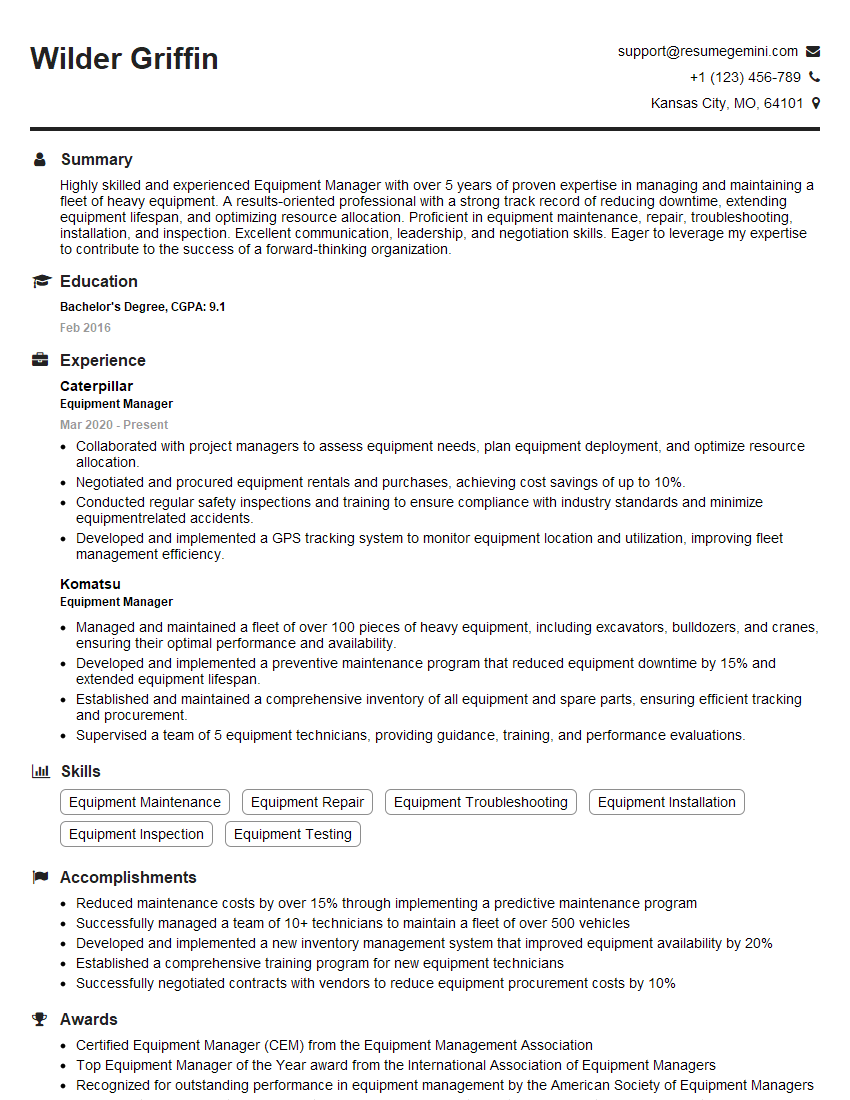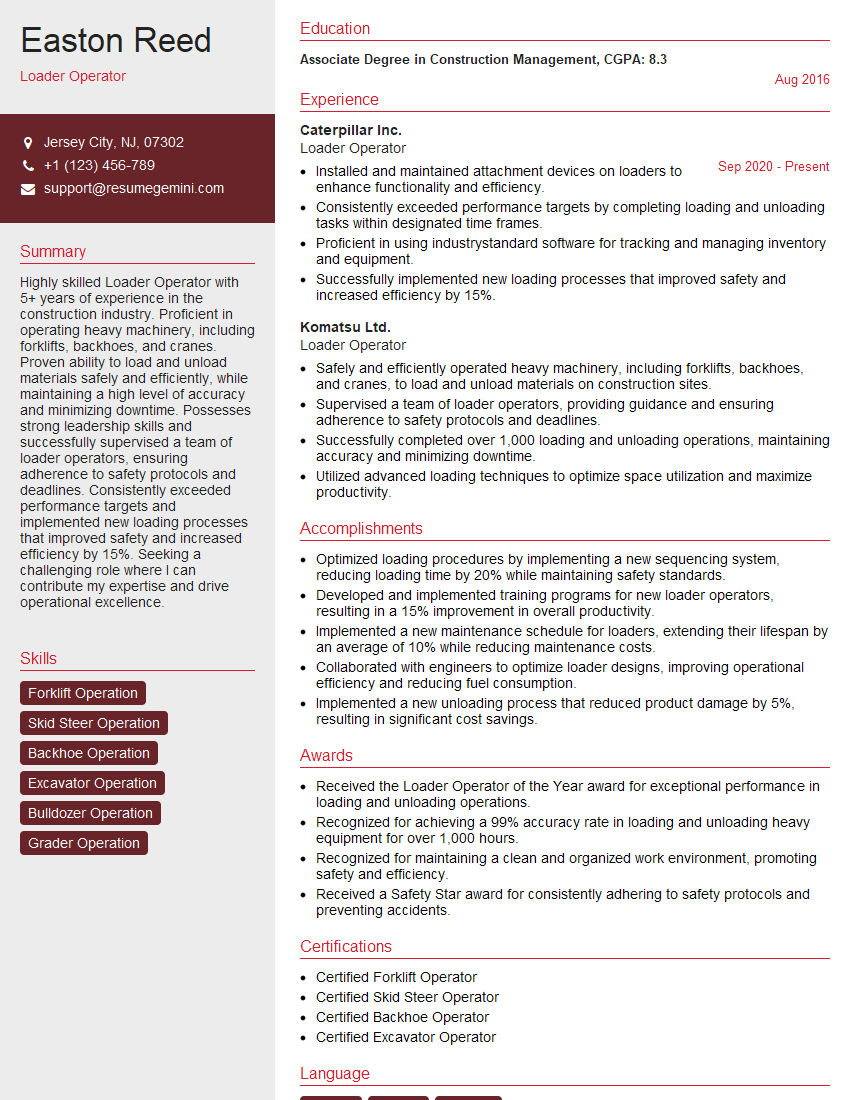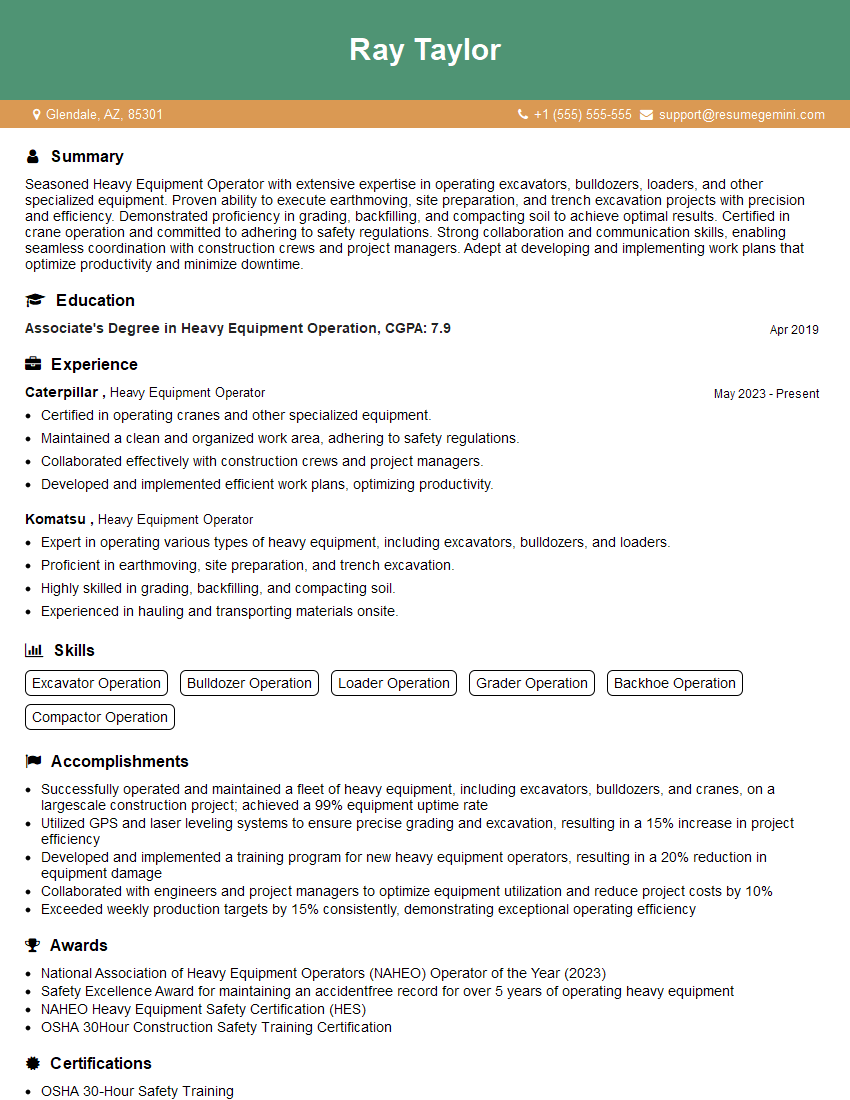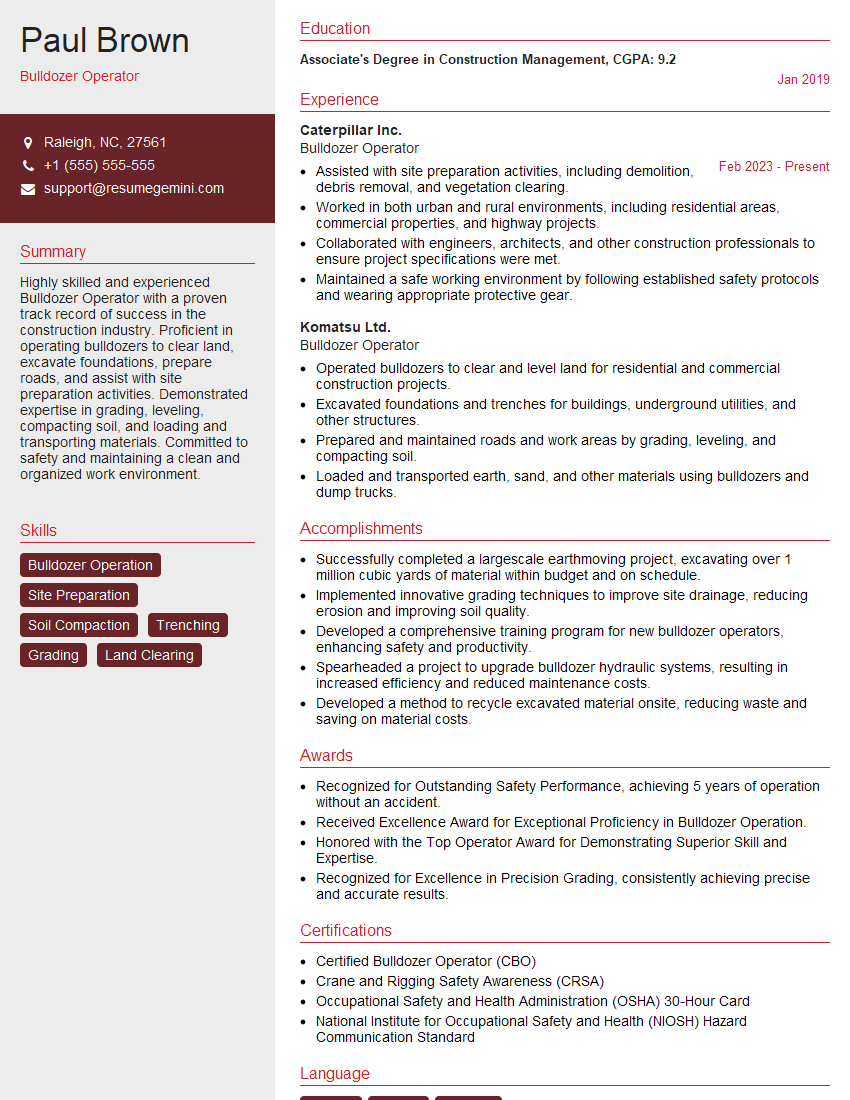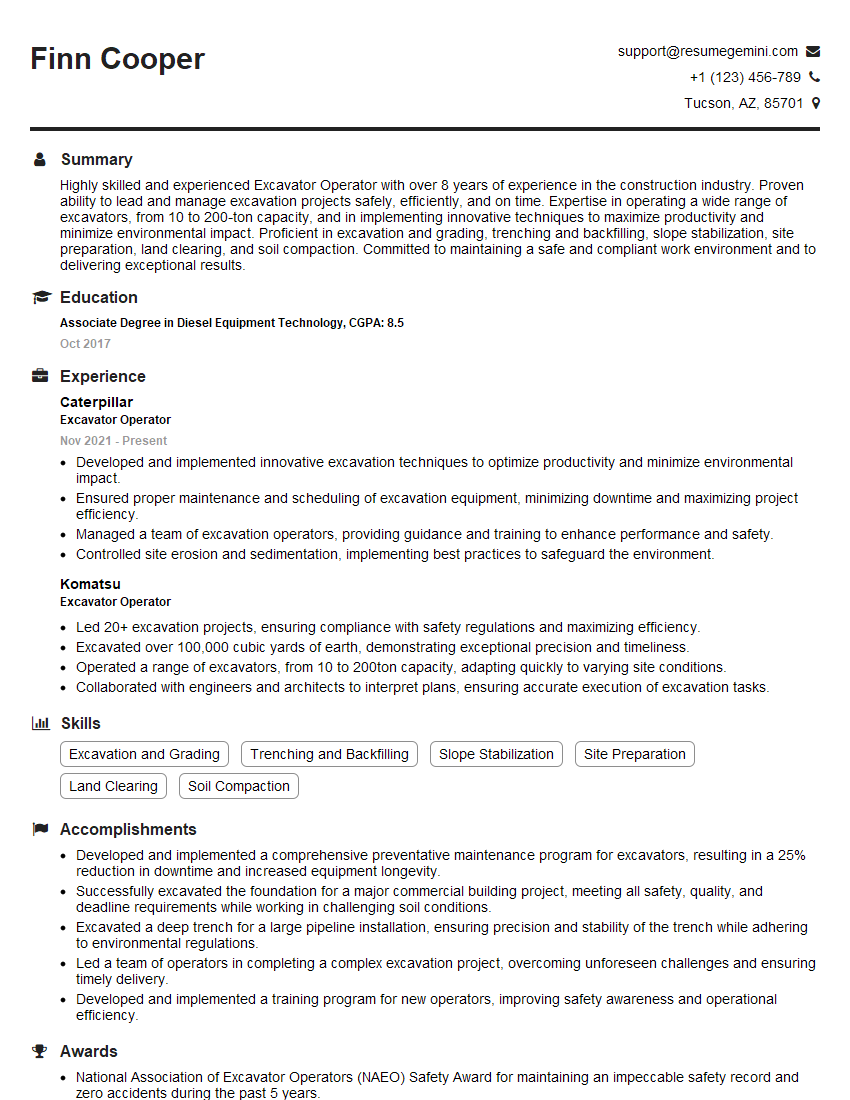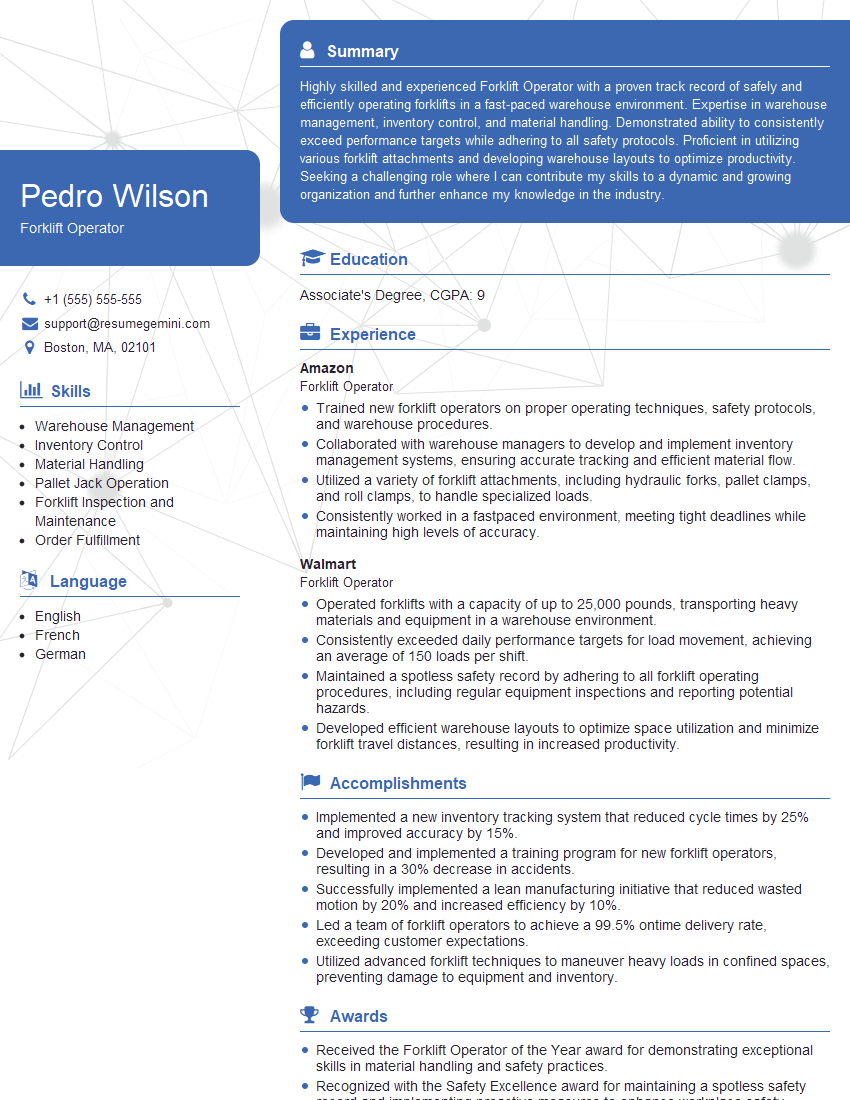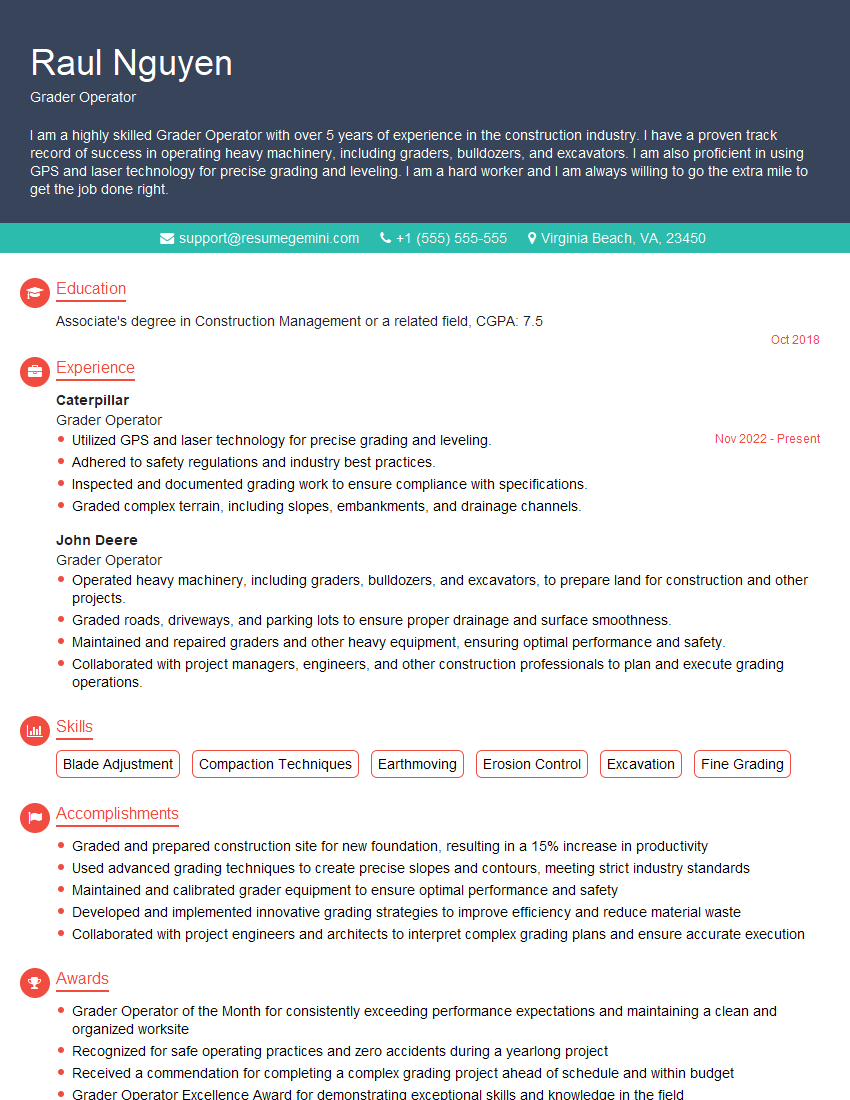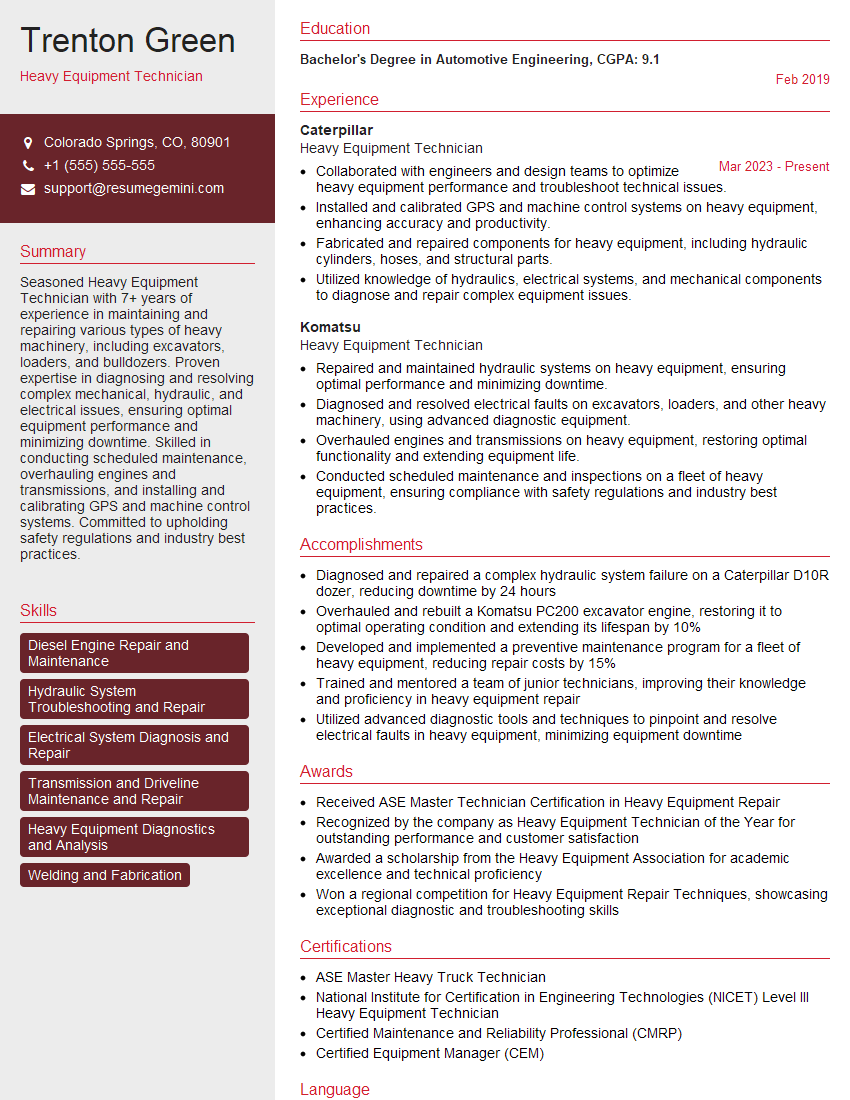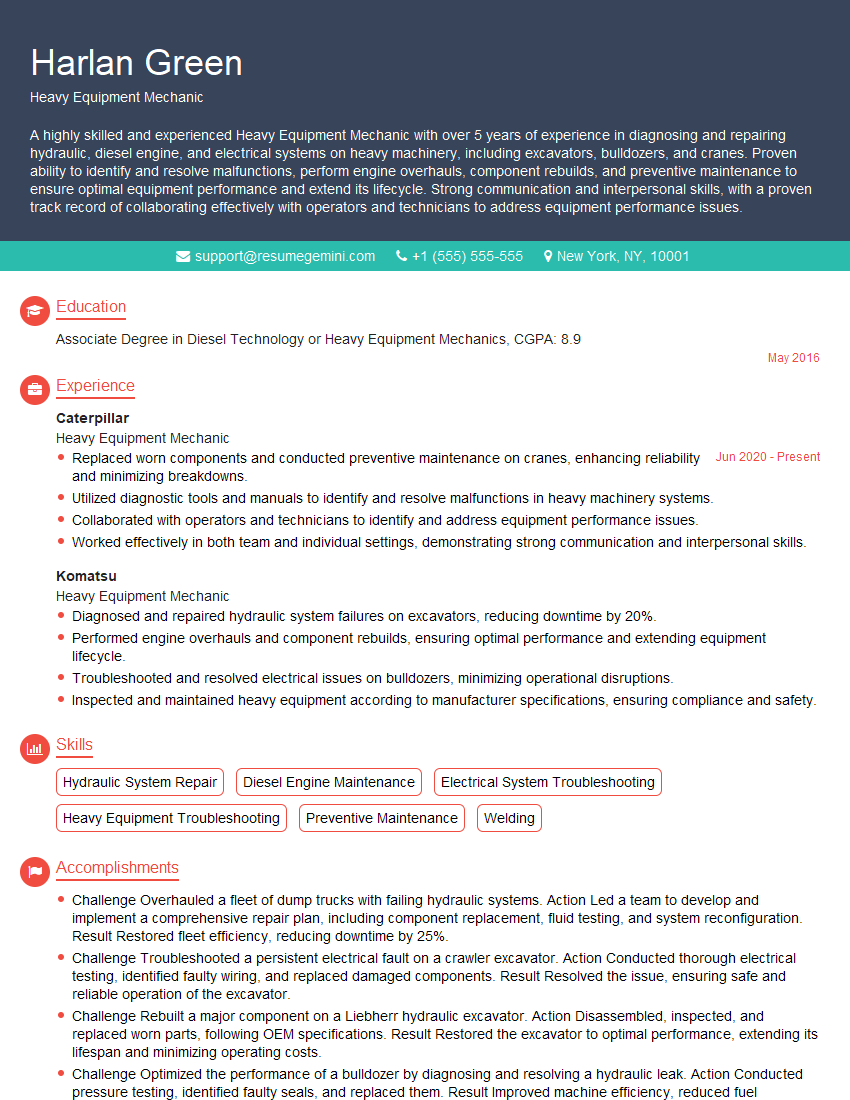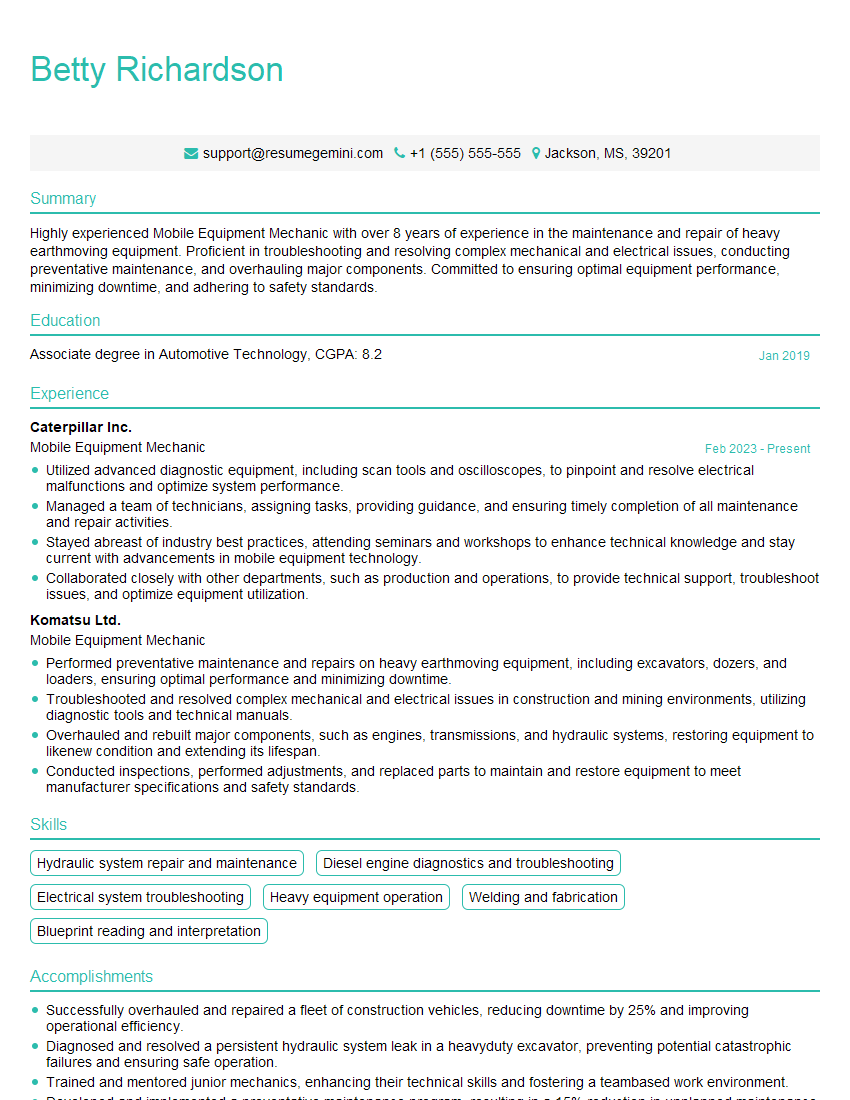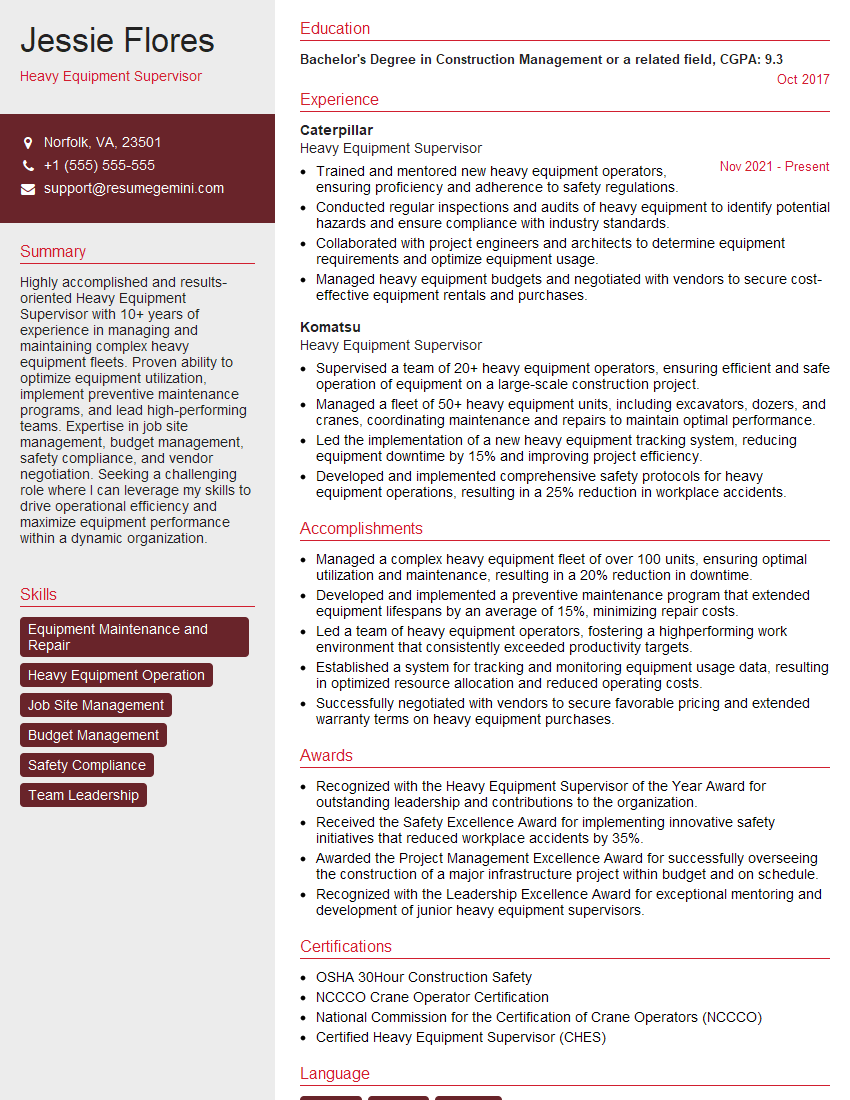The thought of an interview can be nerve-wracking, but the right preparation can make all the difference. Explore this comprehensive guide to Experience in operating and maintaining heavy equipment interview questions and gain the confidence you need to showcase your abilities and secure the role.
Questions Asked in Experience in operating and maintaining heavy equipment Interview
Q 1. Describe your experience operating excavators.
My experience with excavators spans over eight years, encompassing various models and applications. I’ve operated everything from compact excavators for intricate urban projects to larger, heavier machines for large-scale excavation and earthmoving. I’m proficient in both 2D and 3D machine control systems, enabling me to achieve precise grading and excavation, minimizing material waste and maximizing efficiency. For example, on a recent project involving utility line installation, I used a GPS-guided excavator to precisely dig trenches, ensuring minimal disruption to existing infrastructure. This minimized potential damage and significantly sped up the project timeline.
I’m also familiar with different excavator attachments, such as rippers, breakers, and thumbs, allowing me to adapt to diverse job requirements. My skills encompass everything from basic digging and trenching to more complex tasks like demolition and land clearing. I regularly undergo continuing education to stay current with best practices and new technologies.
Q 2. Explain the pre-operational checks you perform on heavy machinery.
Pre-operational checks are crucial for safety and equipment longevity. My routine involves a methodical, multi-stage process. First, I conduct a visual inspection, checking for any obvious damage, leaks, or loose parts. Then, I move to the fluid levels – checking engine oil, hydraulic oil, coolant, and transmission fluid, ensuring they’re within acceptable ranges. I also examine the tires for proper inflation and any visible wear or damage.
Next, I inspect the safety features: seatbelts, emergency shut-off switches, lights, and horns. I test the operational systems, slowly moving each control lever and ensuring smooth operation. I pay close attention to any unusual noises or vibrations. Finally, I review the site conditions for potential hazards – nearby utilities, overhead obstructions, and unstable ground – before beginning any work. Think of it as a thorough ‘health check’ for the machine before starting a shift – just like athletes warm up before competition.
Q 3. How do you troubleshoot hydraulic system failures?
Troubleshooting hydraulic system failures requires a systematic approach. I start by identifying the specific problem – is there a leak, loss of power, or strange noises? A leak, for instance, might be a simple hose failure requiring replacement, or it could indicate a more serious internal problem within a hydraulic component. I’d carefully inspect all hoses and connections, looking for leaks. I also check the hydraulic fluid level and condition – low levels can point to a leak, while contaminated fluid signals the need for a complete system flush.
Loss of power could be due to a variety of issues: a faulty hydraulic pump, a clogged filter, or even a problem with the control system. I would use diagnostic tools to identify the source and make the necessary repairs or replacements. My experience also helps me recognize patterns – a repetitive clicking sound might indicate a failing valve, while a constant whining noise could be a sign of pump wear. Addressing these problems early prevents costly repairs later.
Q 4. What are the common causes of engine overheating in heavy equipment?
Engine overheating is a serious concern, potentially leading to significant damage. The most common causes include insufficient coolant, a faulty radiator, a malfunctioning water pump, a clogged radiator, or a problem with the cooling fan. Sometimes, low oil pressure can also cause overheating. In one instance, I discovered a significant amount of debris blocking the radiator, significantly impeding cooling.
Other potential culprits include a malfunctioning thermostat (preventing proper coolant flow), restricted airflow around the engine (due to debris buildup), and even problems with the engine itself (like a failing head gasket). Regular maintenance, including coolant flushes and inspections, dramatically reduces the risk of overheating. Early detection through monitoring engine temperature gauges is key to preventing catastrophic failure.
Q 5. Describe your experience with preventative maintenance schedules.
Preventative maintenance is the backbone of reliable equipment operation. I’m well-versed in developing and adhering to scheduled maintenance plans, typically based on the manufacturer’s recommendations and adjusted based on usage patterns and site conditions. These schedules encompass regular checks and lubrication of critical components, fluid changes (engine oil, hydraulic oil, transmission fluid, and coolant), filter replacements, and thorough inspections of wear items like belts, hoses, and tires.
I meticulously maintain detailed records of all maintenance activities, including dates, tasks performed, and parts replaced. This detailed record-keeping allows for proactive identification of potential issues and ensures compliance with safety and regulatory requirements. It’s also crucial for predicting potential problems and scheduling major overhauls before they become costly emergencies.
Q 6. How do you handle emergency situations during equipment operation?
Emergency situations demand quick thinking and decisive action. My approach begins with immediate assessment of the situation: What is the nature of the emergency, and what is the level of risk? I always prioritize safety, both my own and that of others in the vicinity. This might involve shutting down the equipment, activating emergency stops, clearing the area, and contacting emergency services if necessary.
In one instance, a sudden hydraulic line failure caused a significant fluid leak. I immediately shut down the machine, secured the area, and initiated procedures to contain the leak. After evaluating the situation and ensuring it was safe, I called the appropriate personnel to address the repair. My training emphasized the importance of swift, controlled responses to mitigate potential damage or injuries.
Q 7. What safety procedures do you follow while operating heavy machinery?
Safety is paramount in my operations. I always begin by conducting a thorough site assessment, identifying potential hazards and establishing a safe working area. I wear appropriate personal protective equipment (PPE), including safety glasses, hard hats, hearing protection, and high-visibility clothing. Before starting any operation, I ensure that all safety features on the machine are functioning correctly, and I follow all established lockout/tagout procedures whenever conducting maintenance or repairs.
Awareness of my surroundings is crucial, paying close attention to other workers, pedestrians, and any potential obstacles. I maintain a safe distance from other equipment and adhere to all site-specific safety rules and regulations. Regular safety training keeps my skills up-to-date, emphasizing risk mitigation and hazard identification. It’s not just following rules, it’s cultivating a safety mindset – a proactive approach to prevent accidents.
Q 8. Explain your experience with different types of heavy equipment.
My experience with heavy equipment spans over 10 years, encompassing a wide range of machinery. I’ve operated and maintained excavators, bulldozers, loaders, graders, and articulated dump trucks in various construction and mining settings. This experience includes both routine operation and complex tasks such as trenching, land clearing, material handling, and road construction. For example, I was responsible for operating a Caterpillar 320 excavator on a large-scale pipeline project, requiring precise control and maneuvering in challenging terrain. My proficiency also extends to smaller equipment like skid steers and forklifts, making me versatile in a variety of situations. I’m familiar with the operating manuals and safety procedures for all types of heavy equipment I’ve used, prioritizing safe and efficient operation above all.
- Excavators: Experienced with hydraulic systems, various bucket attachments, and different digging techniques.
- Bulldozers: Proficient in blade operations for grading, pushing, and land clearing.
- Loaders: Skilled in material handling, loading and unloading trucks, and various bucket operations.
- Graders: Experienced in road construction, maintaining slopes, and ensuring proper drainage.
- Articulated Dump Trucks: Proficient in hauling large volumes of material over challenging terrain.
Q 9. Describe your experience with diesel engine repair and maintenance.
My diesel engine repair and maintenance experience is extensive. I’m well-versed in troubleshooting, diagnosing, and repairing various diesel engine components, including fuel systems, lubrication systems, cooling systems, and air intake systems. This includes performing preventative maintenance such as oil changes, filter replacements, and inspections. I’m comfortable working with different engine brands and models, and I am familiar with using diagnostic tools to identify problems. For instance, I once successfully diagnosed and repaired a faulty fuel injector on a large mining truck, preventing costly downtime and potential damage. This involved using a fuel pressure gauge and diagnostic software to pinpoint the malfunctioning injector and then replacing it following proper procedures.
I understand the importance of preventative maintenance to avoid costly breakdowns. Regular inspections and timely servicing extend the life of the equipment and maintain peak performance. I am proficient in performing major and minor repairs, including engine overhauls when necessary. My skills include cylinder head removal and rebuilding, piston replacement, and crankshaft repair.
Q 10. How do you diagnose and repair electrical problems in heavy equipment?
Diagnosing and repairing electrical problems in heavy equipment requires a systematic approach. I begin by carefully inspecting wiring harnesses, connectors, and components for visible damage. I then use multimeters and diagnostic tools to test circuits and identify voltage, current, and ground faults. A common problem I’ve encountered is faulty sensors leading to improper readings and malfunction. Troubleshooting involves systematically checking wiring, connectors, and sensor readings using the equipment’s manual and diagnostic codes.
For example, I once resolved an issue where an excavator’s boom wouldn’t function correctly. Using a multimeter, I traced the problem to a faulty wiring harness near the boom joint. After repairing the damaged wires, the boom functioned normally. I’m also familiar with using schematics and wiring diagrams to understand complex electrical systems. My experience extends to working with various electronic control modules (ECMs) and understanding their role in equipment operation. Safety is paramount, ensuring disconnection of power before any electrical work begins.
Q 11. Explain your experience with welding and fabrication techniques.
My welding and fabrication skills are a valuable asset in maintaining and repairing heavy equipment. I’m proficient in various welding techniques, including stick welding (SMAW), MIG welding (GMAW), and TIG welding (GTAW). I’m capable of welding various metals, including steel, aluminum, and stainless steel. Beyond welding, I have experience in fabrication tasks, such as cutting, shaping, and assembling metal components. This allows me to create custom parts or repair damaged components on-site, minimizing downtime. For instance, I once fabricated a custom bracket for a damaged loader arm using steel plate and welding techniques, saving the cost and time of ordering a replacement part.
My knowledge extends to selecting appropriate welding techniques and materials for different applications. Understanding metallurgy and material properties is crucial for producing strong and durable welds. I always follow safety protocols, including using proper personal protective equipment (PPE) such as welding helmets, gloves, and protective clothing.
Q 12. How do you maintain accurate records of equipment maintenance?
Maintaining accurate equipment maintenance records is critical for ensuring optimal equipment performance and regulatory compliance. I utilize a combination of digital and paper-based systems to achieve this. I typically use computerized maintenance management systems (CMMS) to log maintenance activities, parts used, and repair costs. This software allows for generating reports and tracking equipment history effectively. CMMS also facilitates preventative maintenance scheduling and alerts for upcoming services.
In addition to digital records, I maintain detailed paper-based logs for each piece of equipment. These logs include daily inspection reports, noting any issues or observations. This detailed documentation is essential for tracking repairs, identifying trends, and ensuring compliance with company and industry regulations. This combination of digital and manual records provides a comprehensive and reliable system for managing equipment maintenance.
Q 13. What software or tools do you use for equipment diagnostics?
I utilize a variety of software and tools for equipment diagnostics, depending on the make and model of the equipment. This includes manufacturer-specific diagnostic software that interfaces with the equipment’s electronic control modules (ECMs). These programs provide real-time data, fault codes, and historical performance metrics. Examples include Cat ET for Caterpillar equipment and similar software for other brands such as John Deere and Komatsu.
In addition to manufacturer-specific software, I also use general diagnostic tools such as multimeters, oscilloscopes, and engine analyzers. These tools are essential for testing electrical circuits, measuring engine parameters, and identifying potential problems. I regularly update my knowledge of the latest diagnostic tools and software to stay current with technological advancements.
Q 14. How do you manage multiple tasks and deadlines in a fast-paced environment?
Managing multiple tasks and deadlines in a fast-paced environment requires a structured approach and strong organizational skills. I prioritize tasks based on urgency and importance, using techniques like creating to-do lists and assigning deadlines for each task. I also leverage technology such as project management software to track progress and keep all stakeholders informed. Effective communication is crucial, keeping my supervisors updated on my progress and any potential challenges.
Proactive problem-solving is critical. I anticipate potential issues and develop contingency plans. I’m comfortable working independently and as part of a team to meet deadlines, often assisting colleagues when needed. Flexibility is vital, adapting to changing priorities and unexpected situations. I thrive under pressure and maintain a calm and efficient demeanor, even during demanding periods. Finally, regular breaks and time management techniques allow me to maintain focus and prevent burnout.
Q 15. Describe your experience working with different types of attachments.
My experience encompasses a wide range of attachments for various heavy equipment, including excavators, loaders, and bulldozers. I’m proficient with buckets (ranging from standard digging buckets to specialized ditch cleaning and demolition buckets), rippers for breaking up hard ground, augers for drilling holes, and hydraulic hammers for demolition work. I’ve also worked with grapple attachments for handling logs and debris, and specialized forks for lifting and moving palletized materials. For example, on one project, we used a specialized rock bucket on an excavator to efficiently move large boulders during a site preparation phase. On another, utilizing a grapple attachment allowed for swift and safe clearing of forested areas. Understanding the specific application and limitations of each attachment is crucial for efficiency and safety.
- Buckets: Digging, ditch cleaning, demolition, rock
- Rippers: Soil and rock breaking
- Augers: Hole drilling for foundations, posts, etc.
- Hydraulic Hammers: Demolition of concrete and rock
- Grapples: Handling logs, debris, scrap metal
- Forks: Lifting and moving palletized materials
Career Expert Tips:
- Ace those interviews! Prepare effectively by reviewing the Top 50 Most Common Interview Questions on ResumeGemini.
- Navigate your job search with confidence! Explore a wide range of Career Tips on ResumeGemini. Learn about common challenges and recommendations to overcome them.
- Craft the perfect resume! Master the Art of Resume Writing with ResumeGemini’s guide. Showcase your unique qualifications and achievements effectively.
- Don’t miss out on holiday savings! Build your dream resume with ResumeGemini’s ATS optimized templates.
Q 16. Explain your knowledge of hydraulic systems and components.
Hydraulic systems are the lifeblood of most heavy equipment. My understanding goes beyond basic operation; I’m familiar with the intricacies of components like pumps, valves, cylinders, and hoses. I can diagnose problems by identifying unusual sounds, leaks, or reduced performance. For instance, a slow-moving cylinder might indicate a problem with the hydraulic pump, a malfunctioning valve, or even a blockage in the lines. I’m experienced in troubleshooting leaks, identifying the source of the leak (e.g., a damaged hose, a faulty seal), and performing the necessary repairs, adhering to all safety protocols. I also understand the importance of maintaining proper hydraulic fluid levels and regularly checking for contamination.
Understanding hydraulic schematics is essential for effective troubleshooting. Being able to trace the flow of hydraulic fluid through the system allows for a logical approach to problem-solving. For instance, if a particular function isn’t working correctly, I can use the schematic to isolate the potential problem areas (pump, valve, cylinder, etc.).
Q 17. How do you interpret and follow maintenance manuals?
Maintenance manuals are my bible. I meticulously follow the recommended schedules for preventative maintenance. This includes regularly checking fluid levels (engine oil, hydraulic oil, coolant), inspecting hoses and belts for wear and tear, and lubricating moving parts. I don’t just skim the manuals; I understand the reasoning behind each step and the potential consequences of neglecting them. For example, a seemingly minor task like changing the engine air filter as per schedule can significantly extend the life of the engine and prevent costly repairs down the line. I also keep detailed records of all maintenance performed, including dates and specifics, making it easier for future troubleshooting and tracking equipment performance.
Beyond scheduled maintenance, the manuals provide crucial information for addressing problems. If a component malfunctions, I consult the troubleshooting sections and follow the step-by-step instructions to diagnose and rectify the issue. I always prioritize safety when using the manuals as my guidance.
Q 18. What is your experience with different types of lubricants and their applications?
Different lubricants have specific applications and properties. I’m familiar with various engine oils (meeting different API standards for different engines), hydraulic fluids (different viscosities for varying temperatures and applications), greases (lithium-based, molybdenum-disulfide, etc. for different moving parts), and gear oils. Choosing the incorrect lubricant can lead to premature wear, component failure, and costly repairs. For instance, using a low-viscosity oil in a high-temperature environment can result in excessive wear and tear on engine components. Selecting the right lubricant for each component, following the manufacturer’s recommendations, ensures optimum performance and longevity of equipment.
I always check for compatibility between different lubricants to avoid potential issues like mixing incompatible fluids.
Q 19. Describe your experience with troubleshooting transmission problems.
Troubleshooting transmission problems requires a systematic approach. I start by listening for unusual noises (whining, grinding, etc.) and noting any performance issues like difficulty shifting gears, slippage, or loss of power. This initial assessment helps narrow down the potential causes. I then check fluid levels and condition. Low fluid levels can indicate a leak; contaminated fluid might signal internal wear. I’m familiar with the different types of transmissions (manual, automatic, hydrostatic) and their typical failure points. I understand the importance of using the correct transmission fluid and regularly checking for leaks or signs of wear. If the problem persists, I might need to consult the service manual or seek professional assistance to avoid causing further damage.
For example, a transmission that slips while under load might indicate worn clutches or a problem with the hydraulic control system. A grinding noise while shifting gears could suggest problems with the gear teeth or synchronizers.
Q 20. How do you handle conflicts or disagreements with coworkers?
Conflicts are inevitable in any workplace. My approach is always to address issues professionally and directly. I focus on finding solutions rather than assigning blame. I prefer to have a calm, open discussion to understand everyone’s perspectives. If a solution can’t be reached through dialogue, I’m comfortable escalating the issue to a supervisor, but always aiming for a resolution that maintains a positive and productive working environment. I believe in teamwork and fostering positive relationships; resolving conflicts effectively contributes to overall team success.
For example, in a past situation, a coworker and I had different approaches to a repair job. Instead of arguing, we discussed the pros and cons of our methods. By collaborating, we found a more efficient and safer solution than either of us would have considered alone.
Q 21. What are your strengths and weaknesses as a heavy equipment operator?
My greatest strengths are my problem-solving skills, meticulous attention to detail, and my commitment to safety. I’m able to quickly diagnose and repair equipment malfunctions, ensuring minimal downtime. My methodical approach helps me avoid errors and prevent accidents. My attention to detail is essential for performing preventative maintenance correctly and identifying potential problems before they become major issues. Safety is always my top priority, both for myself and for those around me.
One area I’m working on improving is my delegation skills. While I’m proficient at handling tasks independently, I want to become better at effectively delegating responsibilities within a team to promote efficiency and collaboration. This involves improving my communication and trust-building skills to ensure tasks are completed effectively.
Q 22. How do you stay updated on the latest technologies and safety regulations?
Staying current in the heavy equipment field requires a multi-pronged approach. It’s not enough to rely solely on initial training; continuous learning is crucial for both safety and operational efficiency.
- Industry Publications and Websites: I regularly read trade magazines like Equipment World and Construction Equipment, and I follow reputable online resources dedicated to heavy equipment operation and safety. These publications often feature articles on new technologies, best practices, and regulatory updates.
- Manufacturer Training and Webinars: Equipment manufacturers frequently offer training courses, both in-person and online, covering new models, technological advancements, and maintenance procedures. I actively seek out these opportunities to enhance my skills.
- Safety Certification Programs: I maintain my certifications, such as OSHA 10 or other relevant safety training, ensuring I’m up-to-date with the latest safety regulations and best practices. This often involves refresher courses to stay compliant.
- Networking with Colleagues: Sharing knowledge and experiences with other operators and professionals in the field is invaluable. Conferences, workshops, and informal conversations provide opportunities to learn from others’ successes and mistakes.
By combining these methods, I ensure I’m always aware of the latest advancements and safety standards, enabling me to operate equipment safely and efficiently.
Q 23. Describe a time you had to solve a complex mechanical problem.
During a road construction project, our excavator’s hydraulic system experienced a sudden failure, leaving the arm completely immobile. The initial diagnosis pointed towards a possible pump failure, a costly and time-consuming repair.
Instead of immediately ordering a new pump, I systematically checked every component in the hydraulic circuit. This involved carefully inspecting the lines for leaks, checking the hydraulic fluid level and quality, and meticulously testing the various valves. Through this process, I discovered a small, almost imperceptible crack in a return line, causing a significant pressure drop that disabled the arm.
This was fortunate, as the repair involved a simple and inexpensive weld, avoiding the significant downtime and expense of a pump replacement. This experience reinforced the importance of systematic troubleshooting and thorough inspections before jumping to conclusions.
Q 24. What is your experience with working at heights or in confined spaces?
I have extensive experience working at heights and in confined spaces. My experience includes operating aerial lifts, working on elevated platforms, and performing maintenance tasks in confined areas such as trenches and equipment compartments.
- Working at Heights: I am trained and certified in the safe use of harnesses, lanyards, and fall protection systems. Before undertaking any task at height, I always conduct a thorough risk assessment and ensure all safety equipment is functioning correctly.
- Confined Spaces: My confined space experience includes understanding atmospheric hazards, proper ventilation techniques, and rescue procedures. I always adhere to permit-required confined space entry protocols, ensuring a safe working environment before entering.
Safety is paramount in these situations. I strictly follow all relevant regulations and use appropriate safety measures to mitigate potential risks.
Q 25. How do you ensure the safety of yourself and others while operating equipment?
Ensuring the safety of myself and others while operating heavy equipment is my top priority. It’s a multi-faceted approach built on a strong foundation of established protocols and situational awareness.
- Pre-Operational Checks: Before starting any equipment, I conduct a thorough inspection, checking fluid levels, tire pressure, and the overall mechanical condition. I also verify that all safety devices, such as lights, horns, and emergency brakes, are functioning properly.
- Safe Operating Procedures: I always adhere to site-specific safety regulations and manufacturer’s instructions. This includes maintaining a safe distance from other personnel and equipment, using appropriate signaling methods, and being mindful of environmental conditions.
- Awareness of Surroundings: I maintain constant awareness of my surroundings, including pedestrian and vehicular traffic, overhead obstructions, and potential hazards. This involves using mirrors, cameras, and spotters as needed.
- Communication: Clear communication with others is critical. I utilize appropriate signaling methods and maintain open communication with supervisors and colleagues.
- Emergency Procedures: I’m familiar with all relevant emergency procedures and know how to react quickly and effectively in the event of an accident or equipment malfunction.
Safety isn’t just a checklist; it’s a mindset that guides every action I take while operating heavy equipment.
Q 26. Explain your understanding of load capacity and stability.
Understanding load capacity and stability is fundamental to safe and efficient equipment operation. Load capacity refers to the maximum weight an equipment can safely lift or carry, while stability refers to the equipment’s ability to remain upright and balanced.
Load Capacity: Exceeding the load capacity can lead to structural damage, equipment failure, and serious injury. I always refer to the manufacturer’s specifications for the load capacity of each piece of equipment, ensuring I never exceed the limit.
Stability: Stability is affected by factors like the weight and distribution of the load, ground conditions, and the equipment’s position. I always ensure the load is evenly distributed, avoid overloading, and choose stable ground conditions whenever possible. Understanding the equipment’s center of gravity is also crucial in maintaining stability.
For instance, when operating a crane, I carefully calculate the load’s weight and its distance from the crane’s pivot point to ensure it operates within its safe working load and is appropriately stable. Similarly, when using a bulldozer, I’m mindful of the terrain to prevent tipping. Ignoring these aspects can result in catastrophic accidents.
Q 27. Describe your experience with different types of ground conditions.
My experience encompasses a wide range of ground conditions, from stable, compacted surfaces to loose, unstable soils. Understanding the characteristics of different ground conditions is essential for safe and effective equipment operation.
- Compacted Soil: This typically offers good support and stability. However, even compacted soil can become unstable due to factors such as moisture content.
- Loose Soil: Operating on loose soil requires careful consideration. I adjust my techniques, operating at slower speeds and using different attachments where necessary, to prevent sinking or getting stuck. I might utilize wider tracks or tires to reduce ground pressure.
- Rocky Terrain: Operating on rocky terrain requires extra caution to avoid damaging the equipment’s undercarriage or getting stuck. I adjust my speed and operating techniques accordingly.
- Wet or Muddy Conditions: Wet conditions significantly reduce traction. I might use chains or special tires to improve traction or postpone work until conditions improve.
Each ground condition presents unique challenges that need to be addressed through careful planning, appropriate equipment selection, and safe operating practices.
Q 28. How do you prioritize maintenance tasks based on urgency and importance?
Prioritizing maintenance tasks effectively requires a systematic approach that balances urgency and importance. I typically use a combination of methods to achieve this.
- Preventative Maintenance Schedules: I follow manufacturer-recommended preventative maintenance schedules for all equipment. These schedules outline routine tasks that help prevent major breakdowns, such as oil changes, filter replacements, and inspections.
- Condition Monitoring: I regularly monitor the condition of the equipment by conducting thorough inspections and checks. This involves noting any unusual noises, leaks, vibrations, or performance issues, that may suggest potential problems.
- Prioritization Matrix: For non-routine maintenance, I use a prioritization matrix, considering both urgency (how quickly the task needs to be done) and importance (how critical the task is to the equipment’s functionality and safety). Tasks are categorized into four quadrants: high urgency/high importance, high urgency/low importance, low urgency/high importance, and low urgency/low importance. High urgency/high importance tasks are addressed immediately.
- Work Orders and Documentation: I maintain detailed records of all maintenance tasks, including the date, type of work performed, and any parts replaced. This helps track maintenance history and facilitates future planning.
This systematic approach ensures that maintenance tasks are performed efficiently and effectively, maximizing equipment uptime and minimizing the risk of unexpected failures.
Key Topics to Learn for Experience in operating and maintaining heavy equipment Interview
- Safe Operation Procedures: Understanding and adhering to all safety regulations and protocols for various heavy equipment types. This includes pre-operation checks, emergency procedures, and hazard identification.
- Equipment Mechanics & Troubleshooting: Practical knowledge of the mechanical components of different heavy equipment (e.g., hydraulic systems, engines, transmissions). Be prepared to discuss troubleshooting common mechanical issues and preventative maintenance strategies.
- Specialized Equipment Knowledge: Depending on the job, you might need expertise in specific types of equipment (e.g., excavators, bulldozers, cranes, loaders). Focus your preparation on the equipment relevant to the roles you’re applying for.
- Maintenance Schedules & Records: Understanding the importance of regular maintenance, keeping accurate records, and interpreting maintenance logs. Discuss your experience in following manufacturers’ recommendations and preventative maintenance schedules.
- Regulations & Compliance: Familiarity with relevant industry regulations, safety standards, and environmental considerations related to heavy equipment operation and maintenance.
- Problem-Solving & Decision-Making: Prepare examples showcasing your ability to diagnose equipment malfunctions, implement effective solutions, and make sound judgments under pressure. Quantify your successes whenever possible.
- Teamwork & Communication: Heavy equipment operation often involves teamwork. Be ready to discuss your collaboration skills and ability to communicate effectively with colleagues and supervisors.
Next Steps
Mastering the operation and maintenance of heavy equipment is crucial for career advancement in construction, mining, and other related industries. It opens doors to higher-paying roles with increased responsibility and opportunities for specialization. To maximize your job prospects, create an ATS-friendly resume that highlights your skills and experience effectively. ResumeGemini is a trusted resource to help you build a professional and impactful resume that will get noticed. Examples of resumes tailored to heavy equipment operation and maintenance experience are available, providing you with a head start in showcasing your qualifications.
Explore more articles
Users Rating of Our Blogs
Share Your Experience
We value your feedback! Please rate our content and share your thoughts (optional).
What Readers Say About Our Blog
Hello,
We found issues with your domain’s email setup that may be sending your messages to spam or blocking them completely. InboxShield Mini shows you how to fix it in minutes — no tech skills required.
Scan your domain now for details: https://inboxshield-mini.com/
— Adam @ InboxShield Mini
Reply STOP to unsubscribe
Hi, are you owner of interviewgemini.com? What if I told you I could help you find extra time in your schedule, reconnect with leads you didn’t even realize you missed, and bring in more “I want to work with you” conversations, without increasing your ad spend or hiring a full-time employee?
All with a flexible, budget-friendly service that could easily pay for itself. Sounds good?
Would it be nice to jump on a quick 10-minute call so I can show you exactly how we make this work?
Best,
Hapei
Marketing Director
Hey, I know you’re the owner of interviewgemini.com. I’ll be quick.
Fundraising for your business is tough and time-consuming. We make it easier by guaranteeing two private investor meetings each month, for six months. No demos, no pitch events – just direct introductions to active investors matched to your startup.
If youR17;re raising, this could help you build real momentum. Want me to send more info?
Hi, I represent an SEO company that specialises in getting you AI citations and higher rankings on Google. I’d like to offer you a 100% free SEO audit for your website. Would you be interested?
Hi, I represent an SEO company that specialises in getting you AI citations and higher rankings on Google. I’d like to offer you a 100% free SEO audit for your website. Would you be interested?
good


